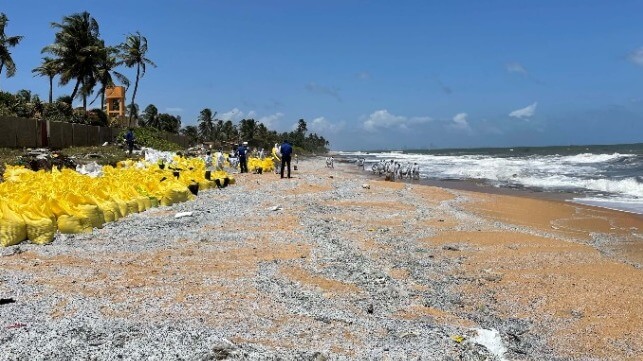X-Press Pearl's Insurer Releases $2.5M for Environmental Cleanup

The insurer of the X-Press Pearl has agreed to pay an additional $2.5 million in compensation for environmental harm in connection to the vessel's sinking off Colombo, Sri Lanka in May.
Sri Lanka's Marine Environment Protection Authority announced Wednesday that the insurer will be compensating the government for some of its cleanup expenses. The payment applies to costs incurred in June, July and August, and covers most - but not all - of the government's claims for the period. MEPA chairperson Dharshani Lahandapura told local media that the total expenditures come to $3.9 million, but more documentation is required first.
The new payment is in addition to a previous tranche of $3.6 million, which covered the cost of the government's initial salvage and environmental response. Separate talks are under way on compensation for fishermen, who were affected by a closure in the affected coastal area. According to Colombo Page, the discussions are proceeding well and the insurer is receptive to the claim.
X-Press Pearl spilled an unknown quantity of chemical cargo into the water when she went down, along with about 1,500 tonnes of plastic nurdles - the small bead-shaped bulk commodity used to make everyday plastic items. It was the largest "plastic spill" on record, according to the UN Environment Programme, and tonnes of this waste have been recovered from nearby beaches.
In a recent study published in the journal ACS Environmental Au, WHOI scientist Anna Michel and Sri Lankan conservationist Asha de Vos reported that the cleanup has a unique challenge. The plastic cargo from X-Press Pearl was released after a raging fire, and a substantial portion of the waste is in a partially-burned state. This makes the assessment and cleanup effort more complex, as the burned particles are variable and harder to spot. Some "don't even look like plastic anymore," according to the authors, and the impact on the environment is not fully known.
"The burnt nurdles span a continuum of colors, shapes, sizes, and densities with high variability that could impact clean-up efforts, alter transport in the ocean, and potentially affect wildlife," the study cautioned.
